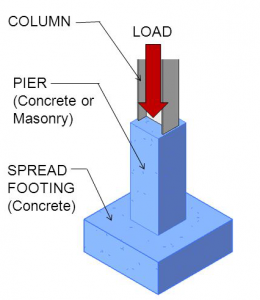Different types of footings
There are different types of footings such are :
- Spared Footing
- Wall Footing
- Isolated Footing Column
- Combined footing
- Cantilever or strap Footing
- Inverted arch footing
Spared Footing
-
It is the most common shallow foundation used to transfer the load of wall or isolated column. the base of the wall or column is spread to distribute the load over a larger area.
-
Spared footing don’t directly rest on soil. Usually about 15 to 30 cm plain concrete of mix 1:3:6 or 1:4:8 called foundation concrete is laid on a base course. The base course provides a leveled and hard surface for spared footing.
The various types of footing described under this classification are :
- Wall Footing
- Column Footing
- Rain force concrete footing
- Inverted arch footing
Wall Footing
In this case, the width of the footing is spread or enlarged by a single step or offset from the wall width to distribute the load over a wider area?
-
This type is generally used for the walls of garden or walls of the temporary light structure. A footing may have a base course of concrete or may be entirely built up of one material: e.g. bricks or stones.
-
Wall footing can be either simple or stepped. Simple wall footing for light loads simple footing is constructed which have only one projection beyond the width of the wall, on either side. This projection is generally not going greater than 15 cm on either side. as a thumb rule for small footing, the width of concrete bearing should be twice the width of the wall. The depth of concrete bedding at least twice the projection.
Steeped footing
-
When the wall carries heavy loads, or when the safe bearing pressure of the soil is not very high, the base width required greater, in that case, it is essential to provide masonry offsets, to achieve larger spread, before the load is transferred to concrete bare.
-
In case of brick walls, the offset should not be 10cm. a thumb rule the width of the bottom bricks course should not be less than twice the width of the wall.
Isolated Footing
-
It is also known as independent footing. It is generally provided under a column to distribute the point or concentrated load in the form of uniformly distributed on the soil. It may be of brick or stone masonry, R.CC etc. this type of footing is also known as pad footing.
-
The shape may be square, rectangular or circular in the plane. It can be either of stepped type or have projections in the concrete base.In case of the heavy loaded column, steel reinforcement is provided in both the direction. In concrete bed. The footing of the concrete column may be simple, stepped or sloped.
Combined footing
-
A combined footing supports two columns.
-
It is used when two column is so close to each other that individual footing would overlap so to avoid overlapping a combined column footing is provided . for supporting both columns is known as combined footing.
Cantilever or strap footing
-
It consists of two isolated connected by a right beam known as a strap. The strap beam does not remain in contact with soil and thus does not transfer any pressure to the soil. The strap serves to transfer the column load into the soil. With equal and uniform soil pressure under both footing.
-
It is provided in a situation when it is not possible to provide footing exactly below the end column. Due to its projection beyond the column face, because of plot restriction or the distance between two heavily column is so large that combined is so large that combined footing will be uneconomical.
Inverted arch footing
-
This type of o foundations used to be provided for multistoried building in olden times. However, with the development of reinforced cement concrete construction practice, inverted arch construction is rarely done these days.
-
However, the advantages of inverted arch construction are that in soft soil the depth of foundation is greatly reduced.


